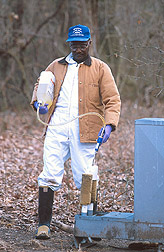This page has been archived and is being provided for reference purposes only. The page is no longer being updated, and therefore, links on the page may be invalid.
| Foundation Licenses ARS-Developed Tick Control DeviceBy Alfredo FloresJanuary 29, 2004 A patented device developed by Agricultural Research Service scientists to protect white-tailed deer from blacklegged ticks is now being sold commercially. The American Lyme Disease Foundation, Somers, N.Y., has been licensed to produce the device, called the "4-Poster" Deer Treatment Bait Station, developed by ARS scientists in Kerrville, Texas. ARS is the U.S. Department of Agriculture's chief scientific research agency. The device was studied for five years, to see if it would control ticks plaguing white-tailed deer in the Northeast. Blacklegged ticks, Ixodes scapularis, and the lone star tick, Amblyomma americanum, transmit the bacterial agent, Borrelia burgdorferi, that causes human Lyme disease. Each year, more than 10,000 human cases of Lyme disease are reported in the United States, according to the U.S. Centers for Disease Control and Prevention. The simple device consists of a bin that's filled with whole-kernel corn. Paint rollers on the four corners of the bin are loaded with a special formulation of permethrin that Y-Tex Corporation, in Cody, Wyo., registered with the U.S. Environmental Protection Agency for exclusive application to deer by the "4-poster." As a deer feeds on the corn in the bin, the animal's head and neck rub against the permethrin-laden rollers, which gives sufficient coverage to protect the entire animal. The 4-poster device offers a viable tick-control alternative to spraying insecticides into the environment that might be toxic to nontarget species. Studies by ARS and cooperators have shown that after two to three years, use of the 4-poster technology will control from 92 to 98 percent of the free-living tick population around the devices. Depending on the size of the herd, each device will treat deer on approximately 40 to 50 acres. Lyme disease occurs mainly in suburban areas where there's an overabundance of deer. The test sites for the device were in areas where some of the highest incidences of Lyme disease in the United States were found when the project started in 1997. |

